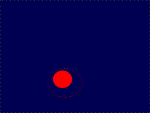
-- A Cyberspace Review Of The Arts
Volume 19.05
May 1, 2012
|
Images from the I Ching
by Robert Sievert The I CHING, a Chinese text, also known as the BOOK OF CHANGES, is comprised of 64 hexagrams and is used as a divining instrument as one hexagram changes into another. The hexagrams are a series of six straight lines on top of each other, some solid, some broken in half. It is of great interest how these six lines command a universe of meaning. For example the hexagram, 'The Joyous (Lake)' changes into the hexagram the 'Creative (Heaven)'. The principal of synchronicity, things existing in the same time frame, comes into play; thus one can interpret the meaning of a situation in question by finding the parallel meaning in the change from one hexagram to another. The meaning one might take is as follows: one of the attributes of the Joyous is perseverance. As it changes into the hexagram the Creative, one of whose meanings is success. Thus perseverance brings success. The hexagrams are selected by tossing coins or counting sticks (yarrow stalks). I have had a number of friends who were diviners and made themselves available to friends to decipher critical moments in life. Some of the oldest examples of written word are hexagrams from the I CHING dating back many centuries before Christ. One of the known authors is Confucius as well as a number of other great Chinese thinkers. The I Ching represents an important component of Taoist thinking. Barry Fishman has a deep interest in the I CHING and the TA CHUAN (THE GREAT TREATISE) as well. While he never uses the I CHING as a divining tool, he has made a series of 80 paintings, 42 x 42 inches, in which he has tried to embody the principles of each hexagram into a design (painting). Some are more interesting than others. I find the more subtle examples (YIN and YANG) less compelling than the more design rich (such as the RECEPTIVE and DIFFICULTY AT THE BEGINNING ) whose vibrant designs excite the eye. Fishman's notes and explanation are explained as such "I have interpreted the I Ching as a visual system where the forms, frames, lines and colors are a direct expression of each ideogram. To my knowledge this has never done before. These paintings are now on view thanks to a dazzling layout on ETAOIN by Gordon Fitch at http://www.etaoin.com/yj_cat00.html. |
|
|
|
|
|
|
|
|
copyright © Robert Sievert 2012 |
|


 Back to the Front
Back to the Front